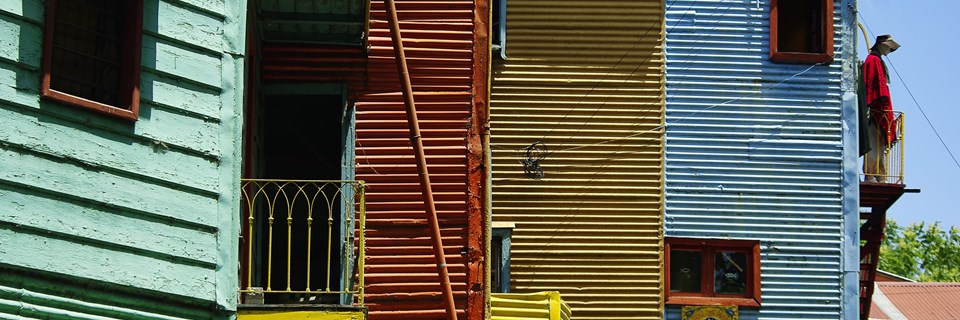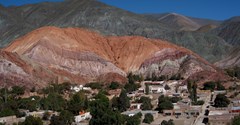Explore the history, culture and local life of Buenos Aires with seven of our favourite ways to experience the Argentine capital.
Located on the banks of the River Plate estuary, Buenos Aires is a stylish and cosmopolitan city, with a mix of Latin American, colonial, and Parisian influences. It is known the world over as being the home of Carlos Gardel and the Tango, of Eva Perón and Peronism, of Diego Maradona and Boca Juniors. But there is more to this city than meets the eye, so enjoy our guide to Buenos Aires to discover seven very different sides to the Argentine capital. Remember that everything below and more can be enjoyed as part of our guided tours and excursions in Buenos Aires.
1. Discover why Buenos Aires is the 'Paris of South America'
The architecture in the northern barrios of Buenos Aires offers a distinctly 19th century European flavour. Upper class neighbourhoods, such as Retiro, Recoleta and Palermo, have retained their stately belle époque feel and won the city the evocative nickname of the 'Paris of South America'. A guided tour around these streets shines a light on the lifestyle of the old families that populated these areas, leading you to splendid palaces, parks and tree-lined avenues and past myriad Parisian style buildings and squares.
The highlight to any visit to these northern districts is the chance to meander through the remarkable Recoleta Cemetery. In this immense but peaceful space you can marvel at towering mausoleums of all shapes and sizes and admire the intricate details of cobweb-covered statues. The most famous tomb here is that of former First Lady Eva Perón, a surprisingly understated family mausoleum which is constantly refreshed with new flowers from visiting devotees. Other notable 'residents' include poets, politicians, writers, 19 former Presidents and even a boxer, a wrestler and a Formula One driver.
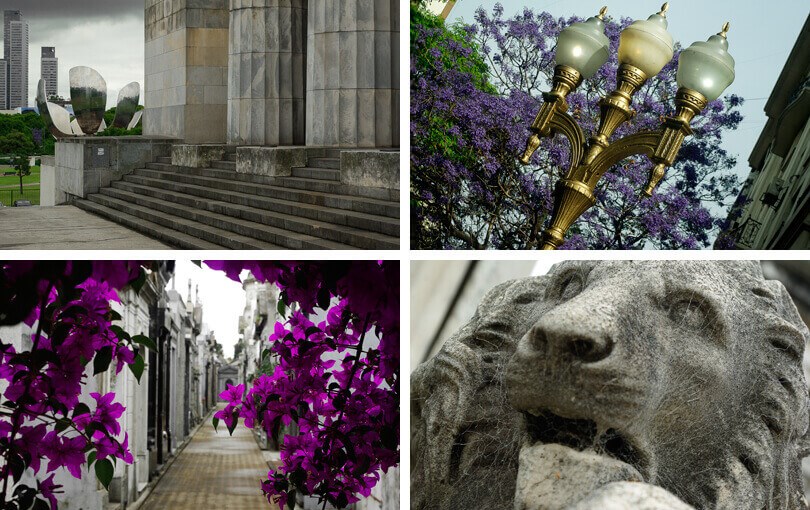
2. Then compare with traditional San Telmo & La Boca
Nestled between the government buildings of the centre and the brightly coloured houses of La Boca is the neighbourhood of San Telmo, whose timeless tango halls, traditional cafes, grand colonial buildings and dusty antique shops whisk you back to another age. Every Sunday its main street is host to a lively flea market offering a variety of tourist knick-knacks, paintings, antiques and crafts, whilst one of its more surprising features is an impressive onion-domed Russian church, overlooking the sleepy Lezama Park.
Continuing south brings you to La Boca, perhaps the most emblematic area of the city, where immaculately dressed tango dancers strut their stuff and local artists sell their creations in front of the array of eye-poppingly colourful corrugated iron houses. This was once a barrio of poor European immigrants who worked on the docklands. Unable to afford traditional paint, they instead used what was left over from the shipyard to decorate their homes, giving the neighbourhood such a vivid and varied look. In fact in La Boca just about the only thing that isn’t painted are the streets upon which you walk; there are benches, street lights, doors and windows of every shade of yellow, blue, red and green. It is here that we also find the La Bomonera football stadium, home to the famous Boca Juniors team.
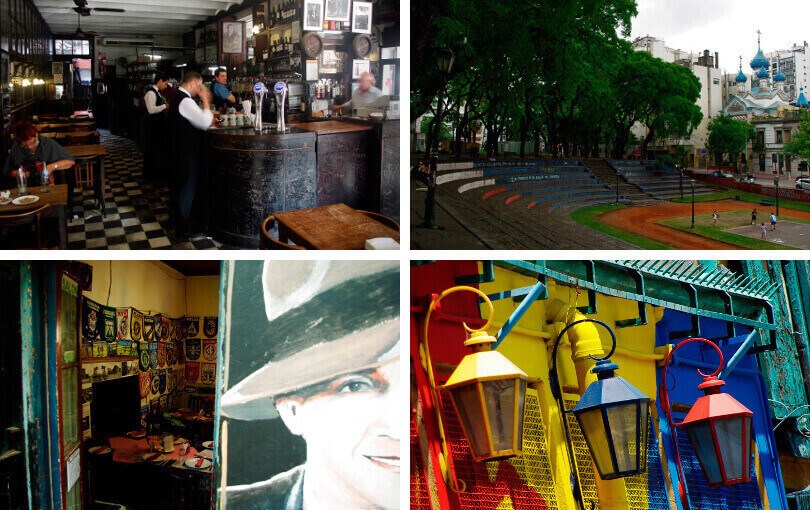
3. Explore the story of the tango and try it for yourself
Few cities and dance forms are as inextricably linked as Buenos Aires and the tango. The origins of the dance are often disputed and shrouded in mystery, though the Argentinian form is said to have arisen from the melting pot of Argentine, African and European cultures of the city's working class population in the late 19th century. The dance spread throughout the city into other towns and across the River Plate into Montevideo in Uruguay, causing unrest among the upper class who frowned upon it. However, once the dance gained popularity in the high society of Europe, Porteños of all social statuses embraced it with gusto. Since then it has formed an integral part of the city's culture and identity.
Tango can be enjoyed on the streets of San Telmo and La Boca, though to truly appreciate its awesome speed and precision, it is best to attend one of the nightly shows held throughout the city. These vary in quality and authenticity, though we have a selection of our favourites that we feel represent the true values and artistic style of the dance and the melancholy tones of the accompanying music. It is also possible to witness a Milonga tango, a similar dance but with more Spanish influences.
Of course, you can always go one step further and try your hand (and feet) at it yourself. Our favourite school is set in a restored mansion, offering the chance to learn in lessons tailored to your experience and dance in opulent surroundings, befitting the style and grandeur of the tango.
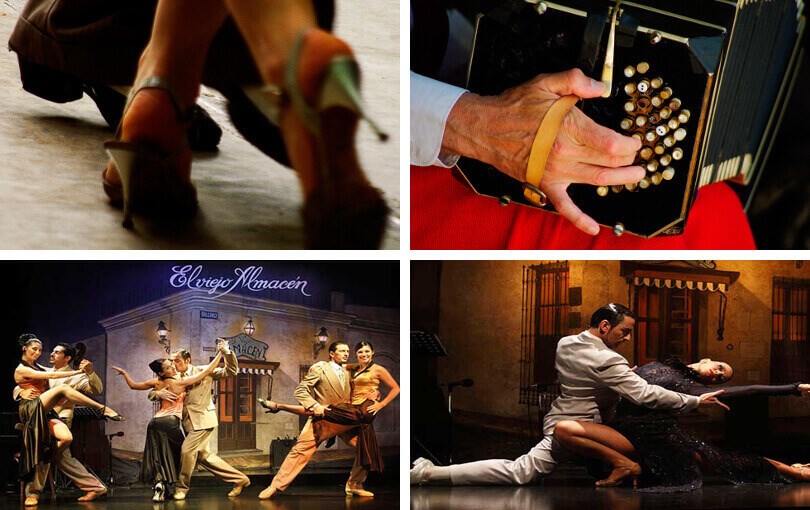
4. Journey through the controversial history of Peronism
To better understand modern day Argentina and how it has been shaped by the events of the 20th century, it is essential to delve into the story of former president Juan Perón and his wife Eva Perón and how their political ideals have both united and divided Argentina's working class.
Since Perón's arrival into power in 1946 Peronism has has been the backbone of Argentina's dominant Justicialist Party; an ideology based on social reform, state intervention and political and economic independence. These values made the president wildly popular, but also set the country on a course of unrest and upheaval that continues today. Perón was ultimately overthrown in 1955, before returning to lead Argentina again in 1973, ending years of military rule. By then the ideals had diverged somewhat, causing friction and in-fighting among Peronistas and they would go on to be further diluted with a move towards free market policies under later presidents.
Of equal significance was Eva Perón, loved and admired for her efforts to support working class people of Argentina, but loathed by the upper classes with whom she constantly clashed. Today it is possible to relive her fascinating and controversial life though the streets, squares, monuments, political buildings and museums of central Buenos Aires, culminating in a visit to her understated tomb in Recoleta cemetery and the Evita Museum in Palermo further north.
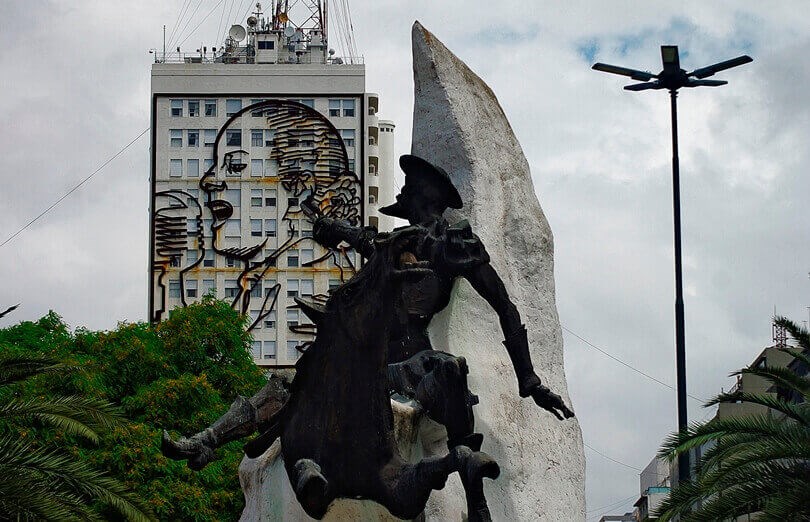
5. Sample Argentina's varied cuisine and world class wines in style
Think of Argentina and it won't be long before thoughts turn to culinary matters - prime beef steaks, Malbec reds and dulce de leche. The capital has a thriving and varied restaurant scene, but the best way to truly get to know Argentine cuisine and sample it in style is at a unique dinner experience in the upmarket Palermo barrio.
A select number of guests from around the world gather to meet, exchange stories and enjoy world-class wines and a smorgasbord of tasty Argentine treats, led throughout by expert guides. You'll enjoy your very own empanada, choosing from a choice of fillings and created using the traditional repulgue technique, before moving on to some of the very best steak in Argentina. For vegetarians and pescetarians you will enjoy a no less tasty alternative. To accompany the dinner you will have the chance to drink two wines from a boutique winery in Mendoza and will be guided through the tasting process.
For desert you will create your own alfajores - the national sweet of Argentina - small biscuits made with dulce de leche, melted chocolate fondue and coconut shavings. To finish it all of you will sample a mate hot drink, prepared in the traditional way with herbs and drunk through a large metal straw with a small filter on the end. It is one of the cornerstones of national identity and has long been an important social activity.
6. Head out to the pampa to experience gaucho life
The vast countryside surrounding Buenos Aires is known as the pampa; vast flat grassland around which are dotted some traditional estancias. Many of these can be reached within an hour or two by road from the capital and are one of the best ways to get an authentic insight into traditional Argentine life in the countryside. Visits here can be spent riding horses, watching polo, learning about the life and work of the gauchos and enjoying the best barbecues of your life. You may chose to stay for longer, but a traditional estancia can be enjoyed on a full day trip out of Buenos Aires to the small colonial town of San Antonio de Areco, 75 miles from the capital.
The town was once the last bastion of civilisation before entering the vast land of the native Indians and has a collection of fascinating museums that allow you to explore this history and culture. You can see examples of 19th and 20th century silverwork, discover the works of Ricardo Güiraldes, one of the most famed exponents of Gaucho literature and admire the paintings of Gaucho life by noted artist Florencio Molina Campos. You will also visit an imitation pulpería, a local store in which Gauchos would gather and which displays typical knives, books, paintings, clothes and utensils.
This perfectly sets the scene for a visit to an estancia and one of our personal favourites is the La Bamba ranch, located at the end of an avenue lined with century-old trees and nestled amongst landscaped parkland. Having toured the colonial era buildings you will have the chance to enjoy the pool, go for a hike, bird-watch or, best of all, go horse-back riding through the grounds on one of the estancia's tame horses.
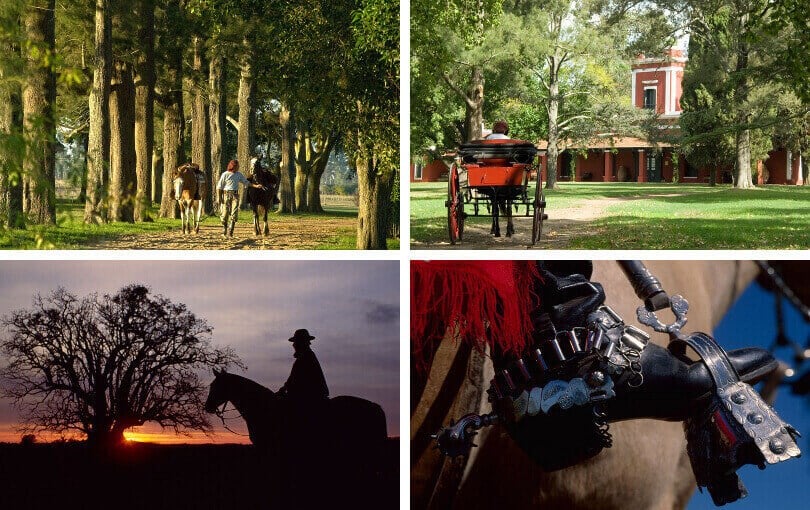
7. Cruise down the exotic Paraná Delta
Another enjoyable day trip out of the city takes you to Tigre to sail along the subtropical rivers and streams of the Paraná Delta - a natural wetlands just outside the capital. Making your way through the lush vegetation, you can relax and observe the rich biodiversity of the area, with colourful flora and bird-life catching the eye.
Tigre, a town enclosed by rivers, was once a thriving playground for wealthy porteños to escape the city and relax amid more tranquil surroundings. Despite an ensuing downturn in its fortunes, plenty of evidence of wealth still exists, as demonstrated by the large catamarans, plush holiday homes and thriving waterfront restaurants that you pass as you sail out of town, confirming that the good times have indeed returned.
Other highlights of the day include the chance to visit the lively fruit market, the Navy Museum (with its relics of the 1982 South Atlantic War) and the Museum of the Reconquista, which celebrates the reconquest of Buenos Aires from the British in the early 19th century. There will also be the chance to see the lesser-visited Olivas barrio in Buenos Aires, where the Presidential Residence is located.
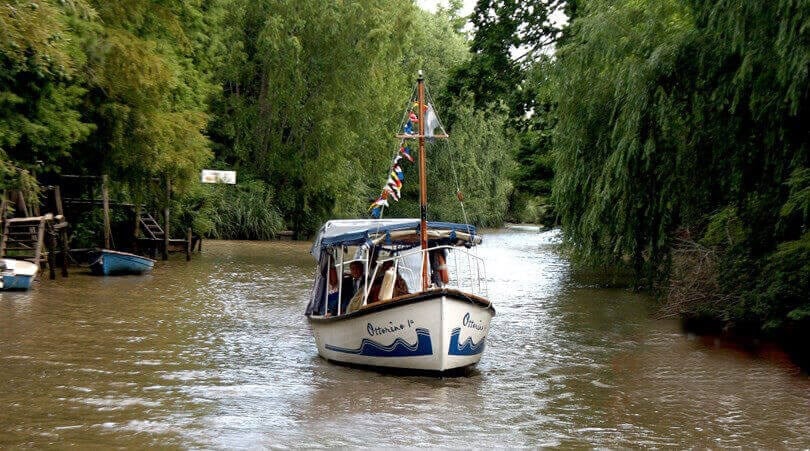 photo by Tigre Municipio
photo by Tigre Municipio
Visiting Buenos Aires
Arrival: British Airways fly direct between London Heathrow and Buenos Aires. You could also chose to combine South American countries and start or finish in Rio de Janeiro, Santiago de Chile or Lima, all of which can also be reached via direct British Airways flights.
Where next: From Buenos Aires you could head up to the Brazilian border to marvel at the Iguazu Falls or fly to the north-west to explore the rock formations and salt flats of Salta. To the west is Mendoza and its beloved vineyards and further south Patagonia starts with the pristine Lake District, accessed from Bariloche. Tierra del Fuego cruises, the Perito Moreno Glacier and the whales and marine birds of Peninsula Valdes are the highlights of Argentine Patagonia, all a short flight away. Finally you could sail across the River Plate to explore Uruguay.
Eat & Drink: Argentina is famed for its delicious empanadas, so it's no surprise to find these stuffed pastries on sale throughout the capital, a perfect afternoon snack. Nothing could be more Argentine than the Parilla, a traditional barbecue restaurant found all over the city offering charcoal-cooked cuts of meat, sausages, melted Provolone cheese and root vegetables. Paired with a glass of Malbec, the country’s most emblematic red wine, a well-cooked steak is one of Argentina’s finest gastronomic pleasures. If you have the chance, you may like to try yerba mate, a hot herbal infusion often drunk among friends through a metal straw. Somewhat bitter and peculiar to the uninitiated, it is a drink that Argentinians the country over swear by, even carrying it with them on the street.
When to Go: The best times to visit Buenos Aires are generally during the Spring (September to November) and Autumn (March to May). This is when temperatures are comfortable, with frequent sunshine, and not too many visitors crowding the streets. November is a good month in particular as it brings with it the blooming of the distinctive Jacaranda tree throughout the city, adding a splash of purple blossom to the city. Summer (December to February) brings hot and humid weather and more tourists, whilst the winter (June to August) tends to be chilly and rainy with few visitors.
Choose your perfect holiday
Find inspiration from our selection of itinerary suggestions, a great starting point for your next trip
View More Tours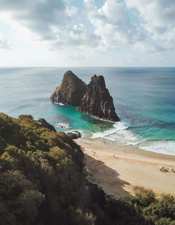
Stay in touch
Infuse your travels, with inspiration from our monthly newsletter.
READY - 20 April 2024
LANDMARK TOURS: Multi-Country & Cross Continent. New Cosmopolitan Tour: Buenos Aires, Iguazu, Rio
CHINA & INDIA: Local Life, People & Unique Cultures
GUIDES by Veloso Tours, are the best Local Hosts
PRIVATE VILLAS: Quality Time in exclusive settings
TRAVEL INSURANCE with extensive COVID-19 cover
